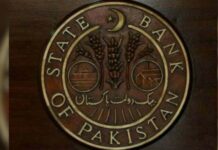ISLAMABAD, Apr 15 (NNI): The World Bank has said that the growing fiscal deficit and high-level of debt are dangerous for the Pakistan economy.
It noted that the federal expenses are one of the biggest reasons for budget deficits, believing that the country can save Rs2,723 billion annually by eliminating unnecessary expenditure and subsidies.
The Bank in its latest report “Pakistan Public Expenditure Review 2023”, said that the persistent low fiscal revenue is one of the drivers of Pakistan’s recurrent budget shortfall, as total revenue collection has been falling over time, with the fiscal year 2018–22 average at 12.5 percent of GDP, down from the fiscal year 2013–17 average of 13.2 percent.
The Bank noted that Pakistan’s total revenue collection averaged 12.8 percent of GDP over the past decade, substantially lower than the South Asian average of 19.6 percent. Tax revenue collection, which averaged 10.3 percent of GDP over the past decade, is also low.
The report says that Pakistan needs to control its growing financial losses and debts. It states that the burden of government employees’ salaries, pensions, and interest payments on loans is piling up.
According to the Bank, federal government gets 46% of the income under the NFC award, while its budget expenditures are 67%, decline in GDP growth is expected to diminish per capita income as well.
The report suggests by curtailing unnecessary expenses and subsidies Rs2 trillion can be saved. By limiting unnecessary expenses, subsidies, and increasing taxes, Pakistan can collect an additional Rs2,723bn.
As per the World Bank, during the fiscal year 2022, Pakistan has reached its highest level of financial losses in the past 22 years. The debt-to-GDP ratio has reached 78% during the fiscal year 2022.
The Bank noted that Pakistan’s widening budget deficit is mainly due to lack of tax collection. It says that Pakistan’s tax system is complex, has a narrow tax base, and has high tax rates. The tax system has numerous special provisions, concessional rates, exemptions, and, to some extent, unorthodox approaches to tax policy. Many of these policy choices were implemented to balance the provision of financial support to certain groups or industries with the need to maintain a minimum level of revenue collection.
To raise more revenue in a sustainable manner, the tax system needs to be simplified, the tax base broadened, and the burden on compliant taxpayers concurrently reduced, the Bank recommended.
Estimates show that past efforts to broaden the tax base have not resulted in tangible outcomes: in the fiscal year 2022, Pakistan lost a total of 2.6 percent of GDP to tax concessions, 0.2 percentage points more than in the fiscal year 2020. Pakistan annually lost an average of 26, 18, and 30 percent of sales tax, income tax, and customs duty revenue potential, respectively, between the fiscal year 2020 and fiscal year 2022, it added.
The sales tax base is narrow with multiple exemptions, concessionary rates, and zero ratings, all contributing to low revenue efficiency. The sales tax base definition is narrow, with multiple exemptions being permitted. In addition to exemptions, the sales tax system also allows for concessionary rates below the standard 18 percent for select products and sectors. Pakistan also allows certain domestic supplies to be zero-rated under the sales tax, which further narrows the tax base. The fractionalized design of the sales tax has resulted in low revenue efficiency.
A VAT gap analysis, conducted with reference to the fiscal year 2019 GDP, reveals that concessionary tax rates, exemptions, and zero-ratings for non-exported products cost Pakistan 15 percent of its revenue potential.
The personal income tax is complex, which allows for income shifting, and contains multiple provisions that narrow its base. Tax-free allowances, tax brackets, and tax rates differ significantly between salaried individuals and other taxpayers, which risks generating economic distortions and creating opportunities for tax avoidance through income shifting. The income tax exemption threshold is set sub-optimally high, leaving formally employed salaried individuals outside of the tax net. At the same time, the threshold for the top income tax bracket for salaried individuals is also very high and is likely to only capture a very limited number of taxpayers.
The corporate income tax (CIT) is complex and features numerous preferential schemes. CIT rates differentiate between three different regimes, with different tax rates and special provisions applying to standard companies, small firms, and small and medium-sized enterprises in the manufacturing sector. These differentiations generate incentives for firms to split or stay small. Similarly, Pakistan provides certain firms access to a simplified turnover tax regime, which is both financially lucrative for the firms and reduces incentives for them to invest in accounting, business formalization, and growth. The CIT regime also provides various tax incentives. These include outright tax holidays, reduced rates, credits, and exemptions granted by sector, investment type, and location.
The report noted that Pakistan’s fiscal deficit has been persistently large and growing, posing risks to fiscal and debt sustainability. In the fiscal year 2022, Pakistan’s general government deficit stood at 7.9 percent of GDP, matching that in the fiscal year 2019, to be the largest in more than 22 years.\
In addition to being persistently high, averaging at 6.2 percent of GDP over the past decade, the deficit has also been growing, with the post-2010 annual average being 50 percent larger than its pre-2010 average. The large recurrent budget shortfalls have led to a rapid accumulation of public debt, which reached 78.0 percent of GDP in the fiscal year 2022, slightly lower than the record high of 81.1 percent of GDP in the fiscal year 2020.
Accordingly, both the deficit and debt levels are in breach of the fiscal rules stipulated by the Fiscal Responsibility and Debt Limitation Act (FRDLA). As a result of the large debt stock, interest payments at 4.7 percent of GDP account for over one-third of its total federal expenditure in the fiscal year 2022.
In the fiscal year 2022, combined federal and provincial expenditure stood just above Rs13 trillion, around 19.7 percent of GDP, with the federal government accounting for about two-thirds at 13.5 percent of GDP. While these levels are not high by international standards, the spending pattern is strikingly rigid, with almost 70 percent of total spending per year being allocated to pre-committed areas such as interest payments, transfers and subsidies, and payments to public sector staff.
These levels are higher than that of regional peers.
Consolidated development spending in Pakistan stood at 2.5 percent of GDP in the fiscal year 2022, of which the federal government contributed about 84 percent. These levels are very modest and lower than that of regional peers; India’s general government capital spending in the fiscal year 2021 stood at 6.7 percent of GDP. Low levels of investment have been a driving factor in Pakistan’s recurrent boom–bust cycles and have contributed to low growth in productivity, potential output, and employment.
The Bank stated that the defense sector is the second-largest recipient of public funds. Defense spending has been steady over the last ten years and has absorbed 2.12 percent of GDP or 16 percent of total spending in the fiscal year 2022.
The Bank further stated that the 18th Amendment and the 7th NFC Award together have resulted in significant vertical fiscal asymmetry. According to the 7th NFC Award, approximately three-fifths of the consolidated revenues accrue to the provinces, while the Federal Government is responsible for two-thirds of total general government expenditures.
In the fiscal year 2022, the Federal Government only retained around 46 percent of total tax revenue, despite shouldering about 67 percent of the total general government expenditure. Therefore, this post-2010 combination of lower retained revenues but with higher expenditures at the Federal Government level has contributed to large recurrent federal fiscal deficits.
The rationalization of overlaps between federal and provincial spending provides opportunities for fiscal savings.
i. Spending by federal ministries focused on devolved subject areas, such as those for health and education, amounted to Rs. 328 billion or 0.5 percent of GDP in 2022.
ii. The federal government also continues to engage on devolved subjects through semiautonomous bodies that focus on devolved service delivery areas, such as the Higher Education Commission (HEC) and the National Commission for Human Development (NCHD). Spending on the HEC was Rs. 70 billion or 0.10 percent of GDP in the fiscal year 2022.
iii. The federal government funds or co-funds vertical programs, such as the BISP, that directly provide services in the provincial domain. Federal spending on the BISP was 0.36 percent of GDP in FY22. The cost-sharing of the BISP where the provinces eventually bear 90 percent of the program could yield Rs217 billion or 0.32 percent of GDP of federal fiscal savings.
iv. There continues to be significant federal development spending on devolved areas, which amounted to Rs. 315 billion or 0.5 percent of GDP in the fiscal year 2022.
Non-budgetary items such as macroeconomic developments – including interest rate increases and exchange rate depreciations – have emerged as key drivers of debt. Between 2012 and 2022, exchange rate depreciation contributed a cumulative 22.5 percentage points (pp) of GDP to the PPG debt level, of which 15 pp occurred over two years, the fiscal year 2019 and fiscal year 2022.
Federal commercial State Owned Entities (SOEs) have been incurring losses since the fiscal year 2016, with annual losses averaging at 0.5 percent of GDP from the fiscal year 2016–the fiscal year 2020. With the persistent losses, the accumulated SOE losses have become substantial, amounting to 3.1 percent of GDP in the fiscal year 2020.
To cover the losses, the Federal Government has been providing direct financial support to the SOEs, in the form of subsidies, loans, and equity injections,19 of which totaled 1.4 percent of GDP in the fiscal year 2021.
In addition to direct support, the federal government has been also issuing guarantees for SOEs to secure loans from commercial banks. Federal government exposure to SOEs, defined as the outstanding stock of guarantees and government loans to SOEs, has been rapidly increasing and stood at 9.7 percent of GDP in the fiscal year 2021, the report added.
Critical corporate governance reforms, such as the implementation of the SOE Governance and Operations Law (2023), the finalization of the SOE Ownership Policy, and the operationalization of the SOE Oversight Unit, are still pending. NNI










































